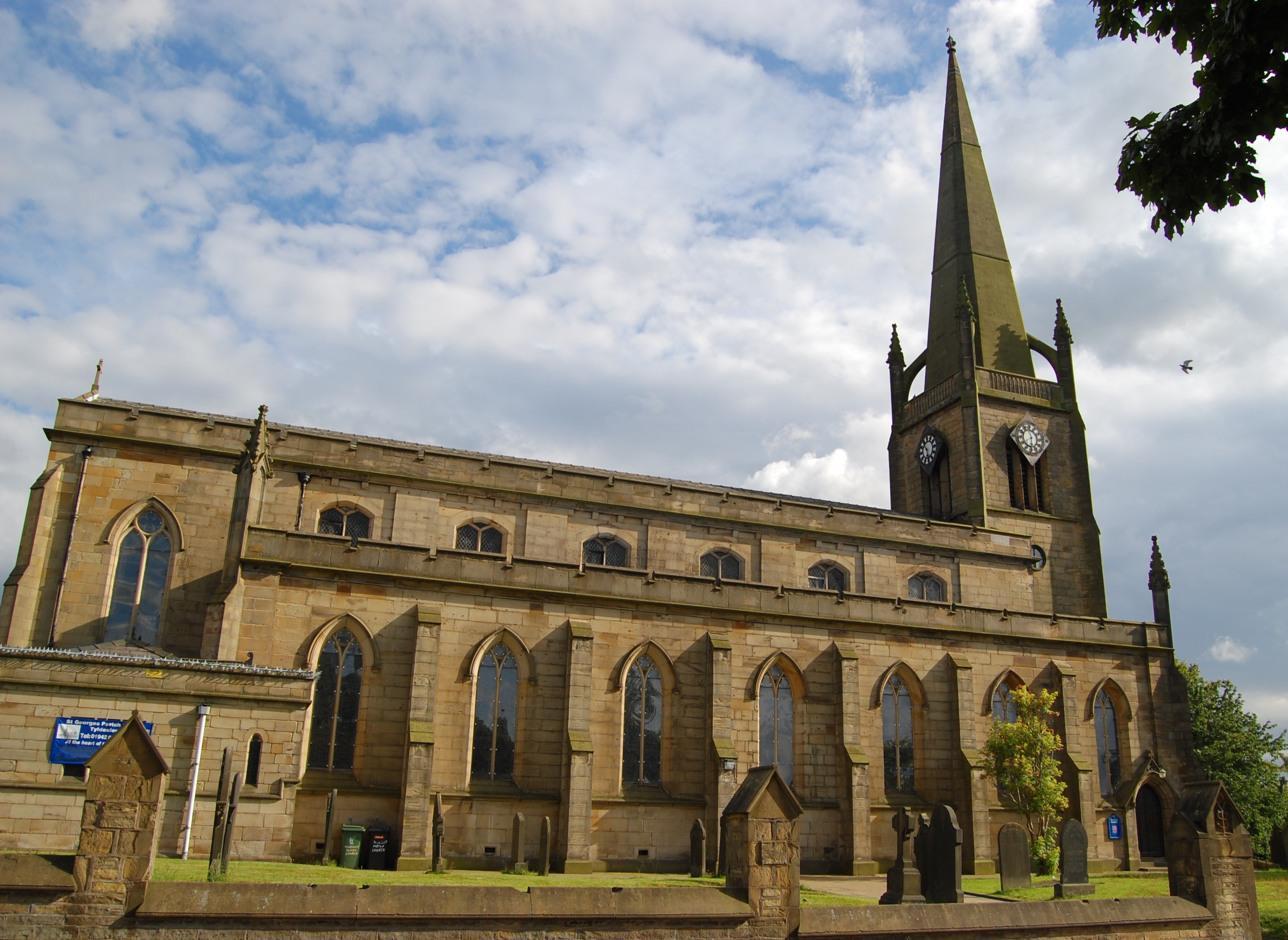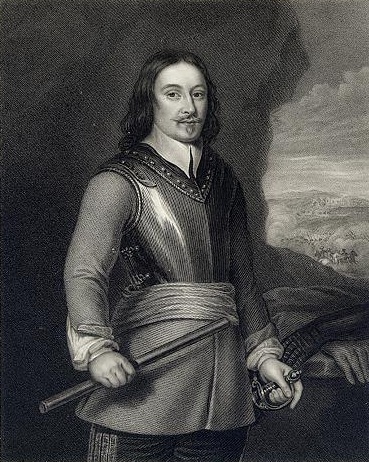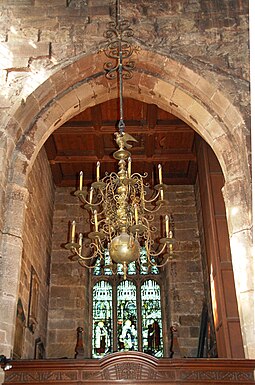St Mary the Virgin is the Anglican parish church in Leigh, Greater Manchester. It is a member of the Leigh deanery in the archdeaconry of Salford, diocese of Manchester.[1][2] It is recorded in the National Heritage List for England as a Grade II* listed buildingStructure of particular architectural and/or historic interest deserving of special protection..[3]
The town-centre church has an early foundation. The Church of Westlay in Legh was built straddling the ancient boundary between Westleigh and Pennington as the parish church for six medieval villsHistorical term describing a unit or area of land containing several dwellings. Chapels of easeChurch subordinate to a parish church serving an area known as a chapelry, for the convenience of those parishioners who would find it difficult to attend services at the parish church. were built in the surrounding townships, the first in Astley in 1631 and the last in Pennington in 1854.
The ancient parishAncient or ancient ecclesiastical parishes encompassed groups of villages and hamlets and their adjacent lands, over which a clergyman had jurisdiction. church was probably rebuilt in the 15th century, its tower dates from 1500. Lancaster architects Paley and Austin rebuilt the church, apart from the tower in the Gothic Revival Perpendicular style between 1871 and 1873 and refaced the tower and built the vestry in 1910.
History
St Mary’s is in the centre of Leigh next to the original market place opposite the town hall. The church was mentioned in 13th-century documents, but the date of its foundation is unknown. The first church on the site, dedicated to St Peter, was described as the Church of Westlay in Legh. Its dedication was changed to St Mary the Virgin at the end of the 14th century. The church straddled the ancient boundary between the townships of Westleigh and Pennington, the naveCentral part of a church, used by the laiety. and most of the churchyard in Westleigh, and the chancelPart of a church containing the altar, used by the officiating clergy. in Pennington.[4]
For several hundred years St Mary’s was the mother church for the six villHistorical term describing a unit or area of land containing several dwellingss that made up the ancient ecclesiastical parish: Westleigh, Pennington, Bedford, Astley, Atherton and Tyldesley, .[4] For baptisms, marriages and funerals their populations had to travel to St Mary’s or churches that lay outside the parish boundary, such as St Mary’s Deane, All Saint’s in Wigan or St Mary the Virgin in Eccles. The first Astley Chapel was built as a chapel of easeChurch subordinate to a parish church serving an area known as a chapelry, for the convenience of those parishioners who would find it difficult to attend services at the parish church. and consecrated in 1631. A second chapel of ease dedicated to St John the Baptist at Chowbent was built in 1645 by John Atherton but not consecrated until 1723. A third daughter church, St George’s
Waterloo church dedicated to St George, completed in 1825 to serve the growing township of Tyldesley cum Shakerley. in Tyldesley, was consecrated in 1825. St Thomas in Bedford was built in 1840 and Christ Church, Pennington in 1854.
Leigh was in the Diocese of Lichfield and Coventry until 1541, when it was transferred to the Diocese of Chester. In 1847 Leigh became the only parish in the Hundred of West Derby to be part of the new Diocese of Manchester. Leigh has had its own deanery since 1933. Until then it had been part of the deanery of Eccles, and earlier still Warrington.[4][5]
The early history of the church was linked with the Lords of the Manor of Westleigh. John de Westleigh was parish priest in the reign of King John (1199–1216).[4] The church was probably rebuilt during the 15th century. The tower dates from about 1500. A chantry chapel dedicated to St Nicholas, known as the Tyldesley Chapel, occupied the east end of the north aisle, and the Atherton Chapel, dedicated to St Mary the eastern end of the south aisle. The tower was restored in 1721 and again in 1849. By the late 1860s the church had become unsafe.
In 1871–1873 the church, apart from the tower, was rebuilt by the Lancaster architects Paley and Austin at a cost of £8,738 providing seating for 710 people.[6] James Fraser, Bishop of Manchester reconsecrated the building in February 1873. In 1890, the successors on the Lancaster practice, Paley, Austin and Paley, refitted the chancel, including the altar and reredos.[7] In 1909–1910 the same practice, then known as Austin and Paley, added a choir vestry to the north of the church, and recased the tower.[8]
During the 1871–1873 reconstruction the date 1616 was found on a roof beam but it is thought the roof of the St Nicholas or Tyldesley Chapel which was restored and reused dates from about 1500. Sir Thomas Tyldesley
Supporter of Charles I and a Royalist commander during the English Civil War. was buried here after his death in the Battle of Wigan Lane.[9]
The 18th-century boundary wall, gates and gate piers of the churchyard are designated as a Grade II listed building.[10]
Structure
The church was rebuilt on the foundations of the original church in hammer-dressed sandstone in the Gothic Revival Perpendicular style.[11][a] Brandwood et al. comment that this is an early use of the Perpendicular style in the Gothic Revival in such “a very conscious and very demonstrative use of the style”, and state that there is “no comparable example in England from about this time”.[12] The church has a six-bay nave and two-bay chancel under a continuous roof with a clerestory and crenellated parapet. The bays have three-light aisle windows with rectilinear tracery and hoodmoulds, the clerestory windows have two-light flat-headed arches. There are octagonal pinnacled piers at the east corners of the chancel, either side of the five-light east window. [3]
The tower, is also castellated and retains its 16th-century studded oak west doors beneath an elliptical arch.[3] The tower has weathered diagonal buttresses and a three-light west window. Below the clock faces are two-light belfryStructure in which bells are hung. openings on all sides. The north vestry dates from 1910. Nikolaus Pevsner describes the six-bay interior with octagonal piers as being “impressive in scale”. The roofline of the previous church is visible on the wall of the tower inside the church. The north aisle roof is re-used from the old church, and the nave has a hammer-beamStructural framework of timbers designed to bridge the space above a room and to provide support for a roof. roof.[11]
Fittings and furniture
The tower has a ring of eight bells. Six were cast in 1740 by Abel Rudhall of Gloucester, and the treble and second were cast in 1761, also by Rudhall’s. These bells replaced four others reputed to have been donated by Queen Elizabeth I. Two of the earlier bells were cast in Leigh in 1692 and 1705.[13][14]
Pevsner describes Ausin and Paley’s reredosLarge ornamented wall, screen, or other structure placed behind the altar in a Christian church. and altar as “extremely handsome” and “gorgeously painted” in gold, red and green by Shrigley and Hunt.[11] Stained glass windows installed between 1887 and 1933 in the Lady chapel, south aisle and several in north aisle are also by Shrigley and Hunt while others including the east window are by Charles Eamer Kempe.[3] The Speakman window is of local interest as it depicts scenes from the industries on which Leigh was built; panels include weavers, engineers and colliers.[15]
The organ case of 1910 is by Austin and Paley, and from the old church there is a 1777 organ case by Samuel Green of London preserved on the vestry side.[11] The three-manual organ was made in 1776–1778 by Samuel Green, and repaired between 1807 and 1877 by Vincent of Liverpool.[16] It was rebuilt in 1911 by Harrison & Harrison, using some original stops. In 1964 the pedal division was enlarged by the same company. The organ has been granted a Historic Organ Certificate Grade II*.[17] Wooden fittings also saved from the earlier church include an altar table of 1705 by Thomas Naylor in the Lady Chapel, and oak canopies from the churchwardens seats of 1686.[3]
Over the nave near the tower is an 18th-century brass chandelier, “a cut above the norm” according to Pevsner, which was retained from the old church and converted to electricity.[11][15]
Notes
| a | Brandwood et al. comment that this is an early use of the Perpendicular style in the Gothic Revival in such “a very conscious and very demonstrative use of the style”, and state that there is “no comparable example in England from about this time”.[12] |
|---|



